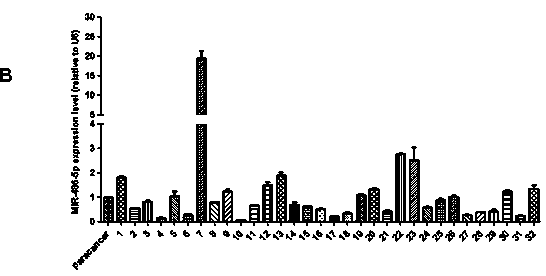Application of miR-486-5p in non-small cell lung carcinoma cell line
A non-small cell lung cancer, cell technology, applied in the field of application of miR-486-5p in non-small cell lung cancer cell lines
- Summary
- Abstract
- Description
- Claims
- Application Information
AI Technical Summary
Problems solved by technology
Method used
Image
Examples
Embodiment 1
[0037] Example 1: According to Solexa sequencing results, it is determined that miR-486-5p is lowly expressed in non-small cell lung cancer cell lines
[0038] The k-ras gene mutant mouse lung cancer model (L703T2) and normal lung cancer model (L1805) used in the present invention were provided by the research group of Professor Ji Hongbin, Institute of Biochemical Cells, Chinese Academy of Sciences.
[0039] The lung tissue of normal mice and the lung tissue of mice with non-small cell lung cancer were sampled, the tissue was lysed by TRIZOL method, chloroform was added, and the protein and nucleic acid were separated. After centrifugation again, the precipitate was washed with ethanol and dried to obtain total RNA. The cDNA libraries of the two tissues were constructed using the reverse transcription kit from TaKaRa Company, reverse transcription was performed with oligo dT as the primer, and the cDNA for subsequent experiments was obtained through two steps of denaturatio...
Embodiment 2
[0041] Example 2: Effect of miR-486-5p on the proliferation of H1299 cells
[0042] Spread the H1299 cells evenly in a 96-well plate, and the medium used is 1640. After 24 h, the mimics of miR-486-5p were transferred into the H1299 cells through lipo2000 transfection reagent and co-incubation in serum-free medium. After 6 hours of transfection, replace the cell culture medium, put in fresh culture medium, then immediately add CCK8 reagent, incubate in the incubator for 2.5 hours, then transfer the solution to a microtiter plate, and detect the absorbance value at 450 nm. Measured every 24 hours.
[0043] The test found that compared with the control group, the absorbance of the transfection group decreased significantly, that is, the proliferation rate of the cells transfected with miR-486-5p was significantly lower than that of the control group, indicating that miR-486-5p has the ability to inhibit the growth of H1299 cells. role in proliferation (see image 3 ).
Embodiment 3
[0044] Example 3: Effect of miR-486-5p on H1299 cell cycle
[0045] H1299 cells were evenly plated in 6-well plates, and each sample was replicated three times. MiR-146a-5p mimics were transfected 24 h later. Cells were collected after 48 h. Wash twice with PBS and fix overnight at 4°C with 70% ethanol. Wash once with PBS, digest with 50 mg / ml RNase for 1 h, room temperature. Stain with 50 mg / ml PI for 30 min at 4°C and detect with flow cytometry. (see Figure 4 ).
PUM
 Login to View More
Login to View More Abstract
Description
Claims
Application Information
 Login to View More
Login to View More - R&D
- Intellectual Property
- Life Sciences
- Materials
- Tech Scout
- Unparalleled Data Quality
- Higher Quality Content
- 60% Fewer Hallucinations
Browse by: Latest US Patents, China's latest patents, Technical Efficacy Thesaurus, Application Domain, Technology Topic, Popular Technical Reports.
© 2025 PatSnap. All rights reserved.Legal|Privacy policy|Modern Slavery Act Transparency Statement|Sitemap|About US| Contact US: help@patsnap.com



